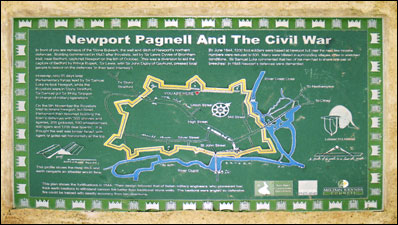![]()
The contents on this page remain on our website for informational purposes only.
Content on this page will not be reviewed or updated.
 |
|
 |
|
|
||||
|
Newport Pagnell: Civil War
|
||||
|
||||
|
During the English Civil War, the Royalists realised the strategic importance of Newport Pagnell, and at the end of summer 1643 they seized the town and “forced the inhabitants to come in and intrench it and draw the river about it the better to strengthen and fortifie it …”
Thereupon the Earl of Essex sent a force under Major General Skippon to drive them out, and with this accomplished on Friday, October 27th they took possession, and not only continued the fortifications but also launched attacks on the Cavaliers in the proximity, including a night raid on Stony Stratford, in which 18 prisoners were taken. Establishing his headquarters at the Saracen’s Head (adjoining the Swan) in January 1644 Sir Samuel Luke became the Governor of the town, and his attention would soon turn to repairing the fortifications, for in March heavy rain caused the earthworks to give way. In fact with Royalists stationed at Buckingham the rebuilding was imperative, as evidenced by the 3,500 or so labourers. Barracks were built in the Market Place (part of the building being used in later years for waterworks), whilst as for the townspeople, no one was allowed out after 9 p.m. By June the garrison comprised 1,200 foot, and with one of these being John Bunyon, of Pilgrim’s Progress fame, the town also gained note as the situation where Cromwell’s namesake son is said to have died, from smallpox. As the sometimes haunt of the notorious Captain Pollard, by whom the rector of Tyringham was badly maimed, Whaddon Chase provided a space where Luke’s falconers could exercise their feathery charge. However, it was also a useful source of timber for the town’s fortification, and - by an order of the Buckinghamshire Committee at Aylesbury - on March 28th 1645 Luke was commanded to procure ‘100 loads of timber out of the woods of the Earl of Antrim at Whaddon, and 2,000 poles out of the College Woods there.’ Apart from the Cavaliers, on occasion Luke had to deal with hostility from his own ranks, especially when Henry Andrewes failed to receive a promised promotion from Captain to Major. This was despite Luke’s earnest endeavours, and when the rank was awarded to a Captain Ennis, Henry mistakenly believed that Luke had been responsible. A feud then developed between the two troops, and ‘I cannot hope for any good from him or his troop, he being heightened and cherished in his discontents by his friends.’ In fact by the spring of 1645 all the local Roundheads seemed demoralised, largely due to want of pay, whilst in other needs Luke wrote “in my company two that had but one payre of Britches between them soe that when one was up the other must of necessity be in his bed.” However, having raised the siege of Oxford, Sir Thomas Fairfax reached Sherington on June 7th and at Newport Pagnell was shown around the fortifications by Luke. In the wake of the decisive Parliamentary victory at Naseby, Luke ordered a public thanksgiving to be held in the parish church, but on the day it became apparent that many people had been drawn to an unorthodox gathering, organised at Lathbury by two Captains of Colonel Fleetwood’s Regiment. Enraged by this impertinence, Luke had the two soldiers arrested as ‘stragglers’ and swiftly sent them back to Sir Thomas Fairfax, Supreme Commander of the New Model Army, in the expectation that ‘such Anabaptistical companions trouble us no more.’ Sir Samuel Luke’s local command came to an end on June 26th 1645, and he was succeeded by Captain Charles D’Oyley. However, during the autumn and winter the troops seem to have become quite lawless, and soon the garrison was reduced to 800 foot and 120 horses. Nevertheless, in 1646 parliamentary dragoons from Newport Pagnell ‘seized upon a poore Bone lace man and a shoemaker near Stony Stratford, robbed them of what they had and sent them away prisoners to Aylesbury …” Therefore it was no doubt a local relief when, in the autumn of 1646, the order came to dismantle the fortifications at Newport Pagnell, and disband the garrison. |
||||
|
|
||||
|
|
||||


